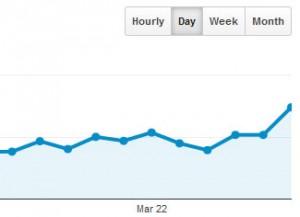Are the statistics true and accurate? And comparable?
We recently passed the five million page views mark, but how does one interpret the numbers on visitor statistics? It is notoriously difficult, both because of what the numbers actually mean varies and because there is no “official” statistics. Per explains more about Internet statistics in this follow-up to the article Five million articles read on BKWine… On web statistics.

You can never really trust statistics about visitors to web sites. First, there are technical limitations that mean that statistics are often underestimated or more or less erroneous. Then, you are generally forced to rely on what the blog or site owner says about statistics. And sometimes they may have an interest to inflate the numbers a bit.
We must therefore take the internet statistics with a pinch of salt, and above all, one should try to understand what the numbers mean and where they come from.
Different types of numbers: unique visitors, page views, etc.
The two main stats measures are unique visitors and page views.
Unique visitors describes, to some extent, how many people have been on the site and read something. You count as a “new” visitor if you have been away from the site / blog for more than X hours. X is often 2 hours but can vary between 30 minutes and 6 hours. It is usually the site owner who decides how long this period is. If you chose a shorter time period then it will increase the visitor statistics. A visitor coming back to the site after more than two hours becomes a new “unique visitors” in the statistics but if instead the limit is 30 minutes you will more rapidly become a new “unique visitors”.
Thus “Unique Visitor” does not at all mean “different people”.
Page views is the second most important parameter. It shows (roughly) how many pages have been visited (viewed) on the site, ie how many articles or posts that have been read.
Another common figure is hits. It is a little more elusive figure. It means, in short, how many “elements” that the server had loaded from the server in order to display a page. A page with two images becomes three hits (the page itself, which is a file, plus two image files). Today this number is often quite meaningless. Pages include lots of images as well as other elements these days and are built in other ways than they were in the past. But it is still an important number for those running the servers at the web hosting company.
Page views per visitor is also sometimes mentioned. This is exactly what it sounds like: the number of pages viewed divided by the number of visitors. It is considered a good thing if you have a “high” number. It means that visitors stay longer on the site.
Average time per visit indicates how long a visitor stays on the site / blog (not on a single page, but on the whole site, possibly visiting multiple pages) before he leaves it. A high number is considered positive.
A sometimes cited number for average page views per visitor is between 1 and 2 and for the time per visit between 30 seconds and 2 minutes. Figures that are higher than that occur mostly on special sites, not pure information sites or blogs (e.g. support sites). Or it can occur if the stats numbers are misinterpreted.
The bounce rate is also an important number. It describes how many visitors come to the site and then exit without going to another page on the same site. In other words, a visitor comes to a page and then leaves without having visited a second page on the site. You want a low bounce rate. It indicates that visitors find more interesting pages once they come to the site.
What tool you use is absolutely critical! Google Analytics, StatCounter etc
![]() It is very important what you use a good tool to measure the statistics, especially if you want to compare. There are a few reliable tools. First of all you have Google Analytics. Almost all serious site owners use Google Analytics today.
It is very important what you use a good tool to measure the statistics, especially if you want to compare. There are a few reliable tools. First of all you have Google Analytics. Almost all serious site owners use Google Analytics today.
Then you can also use other tools such as StatCounter and Clicky. We use all three. There are also some others.
Each statistical tool is a little different and gives slightly different numbers. Each has various technical quirks and limitations. The three that we use provide a comprehensive and consistent picture of our various sites so we think they are reliable.
Never trust statistics from the web hoster!
Stats coming from web hosters are notoriously “unreliable”. (The web hoster is the data centre that manages the servers where the blog is physically located, e.g. GoDaddy). They do supply statistics, but it is usually not comparable to other statistics.
The statistics coming from web hosters are based on entirely different tools and techniques than those I described above. Therefore, it is usually impossible to compare the web hoster’s statistics with stats from e.g. Google Analytics or StatCounter.
The internet hosters’ statistics are often based on “server logs”, ie on an analysis of what is happening on the computers where the site / blog is located. In a way you could argue that these statistics are more reliable than, say, Google Analytics. That may be true, but it is also irrelevant.
The web hosters’ statistics may be more technically “correct” but it can not be compared to statistics from Google Analytics (or similar). And it is GA (and the others), which today has become the standard for web statistics.
200 000 visitors per month!
An example to illustrate the problems with the web host statistics:
A web hosting company that we worked with told us one day we had 230,000 monthly visitors on our site. This was more than 10 times more than what our own statistics showed (based on Google Analytics and StatCounter). It turned out that what they counted as “visitors” was not at all the same thing as Google Analytics “visitors”. We had of course been happy if we had had over 200,000 visitors per month! But we were less happy when they wanted to charge us more for all our visitors.
When you present (or read) internet statistics for you have to be able to interpret the figures correctly. You have to know if it is unique visitors, or page views, or hits, or other things that are shown in the statistics. When I read some of the statistics presented on the sites and blogs that I visit, it is easy to see that not everyone knows how to present things correctly… And it is important to know what tool has been used.
In other words, if you don’t know that the statistics come from Google Analytics, or an equivalent internet tool, and perhaps think that it may come from a web hosting tool (or just simply don’t know), then it is virtually worthless.
An attempt at “official” visitor statistics: SIS Index
 In Sweden (of course, where things are orderly and organised…) there is an attempt to create a common and independent tool to measure and compare (!) visitor statistics and traffic for sites and blogs. It is called SIS Index (Swedish Internet statistics). All sites can participate and it is a free service.
In Sweden (of course, where things are orderly and organised…) there is an attempt to create a common and independent tool to measure and compare (!) visitor statistics and traffic for sites and blogs. It is called SIS Index (Swedish Internet statistics). All sites can participate and it is a free service.
SIS-index is based on Google Analytics and the resulting statistics are available to all. The idea is that it will work much like the independent statistics that is collected for printed newspapers by independent circulation auditing organisations in some countries. Some newspapers participate in such program and others not. (All Swedish wine magazines seem to have chosen not to. Consequently, all wine magazines can claim that they are the “biggest” or “Sweden’s most read” wine magazine. Just like the case is for web sites.)

We have begun a trial to participate in the SIS-Index web statistics. It turns out that we are right now in position 479 of Sweden’s most visited web sites (who participate in the SIS Index).
As far as I know, no other Swedish wine site currently participates in the SIS-Index.
The stats from SIS Index is for a single site, so in our case BKWine Magazine (bkwine.com). If we add to this BKWine Vinresor, BKWine Tours, and BKWine Photography (each an independent site), then we would climb quite a bit in the list.
Why bother with statistics? What are they good for?
Collecting statistics can have multiple purposes. For example:
One reason for gathering statistics is to be able to tell the world how many visitors you have. A “chest thumping” function.
Another reason is to see how the site develops. To see what kind of articles that are popular. To see how the visitors / readers find the site. To see what things work well or what does not work well on a site. (For example: Is it worth while for BKWine Magazine to write about the new wine releases every month? Yes, it is the most read section on the site, so it is time well spent.)
But statistics are most important for those trying to sell advertising. An ad buyer is interested in how many visitors a site has. They want many people to see the advertisement. High visitor numbers are therefore important for an ad-supported site.
Some advice for advertisers
An advertiser on a site (as well as in a newspaper) should be interested in how many readers he reaches. We are ourselves potential advertisers (we would like to get more customers on our wine tours!) So we have looked at some of the questions around on-line advertising.
Here are some things I would consider if I would advertise on a website. I recommend that other advertisers think about them to!:
- What is the number of “unique visitors” and the number of “page views”? (According to the usual definitions)
And also, just as important but not as obvious:
- The numbers come from what statistical tool? If it is something other than Google Analytics or StatCounter (or similar), then I would be hesitant to believe the numbers, especially if it comes from a hosting company’s own stats system.
- Can I see a printout or screen shot from Google Analytics? Then I can interpret the statistics myself. (And verify that it is correct.)
- Is the site registered with the SIS-Index or some other similar independent service?
- Can I get ad serving statistics and click statistics (“click through”) on my ads? (Ie, how many times has my ad been shown and how many have clicked on it.)
With that, I could consider advertising.
Some advice for a site / blog owners

If you are a blog owner or site owner:
If you are not using any statistical tool today, get one now!
It is really interesting to see the visitor statistics. It can also be quite entertaining to read. For example you can see all the unexpected searches that lead people to your site.
If you are not using Google Analytics already, get it now!
But feel free to also use something else, such as StatCounter or Clicky. I actually encourage it. Google Analytics is quite complicated to understand, so it is a good idea to also use a tool that is easier to understand. I would certainly recommend StatCounter.
Do not believe the numbers that you get from your web host’s statistics tool. They may be relevant to see how your site is growing and developing, but they are not comparable to other internet statistics.
And why not try using SIS-Index or some other independent ranking service?
Some advice for readers / site visitors
And for you who are a visitor, reader, or just surfing the web:
Actually nothing. Or perhaps two suggestions:
Allow cookies! Allow at least cookies on the sites you like and that you trust. If you block cookies (most of) the statistics tools will not work. They will not count you. Statistics are often based on cookies.
And also: when you find a site you like, visit it often, go to many pages, browse around. It will bring the site owner joy and happiness!
Don’t miss the related article Five million articles read on BKWine… On web statistics.










